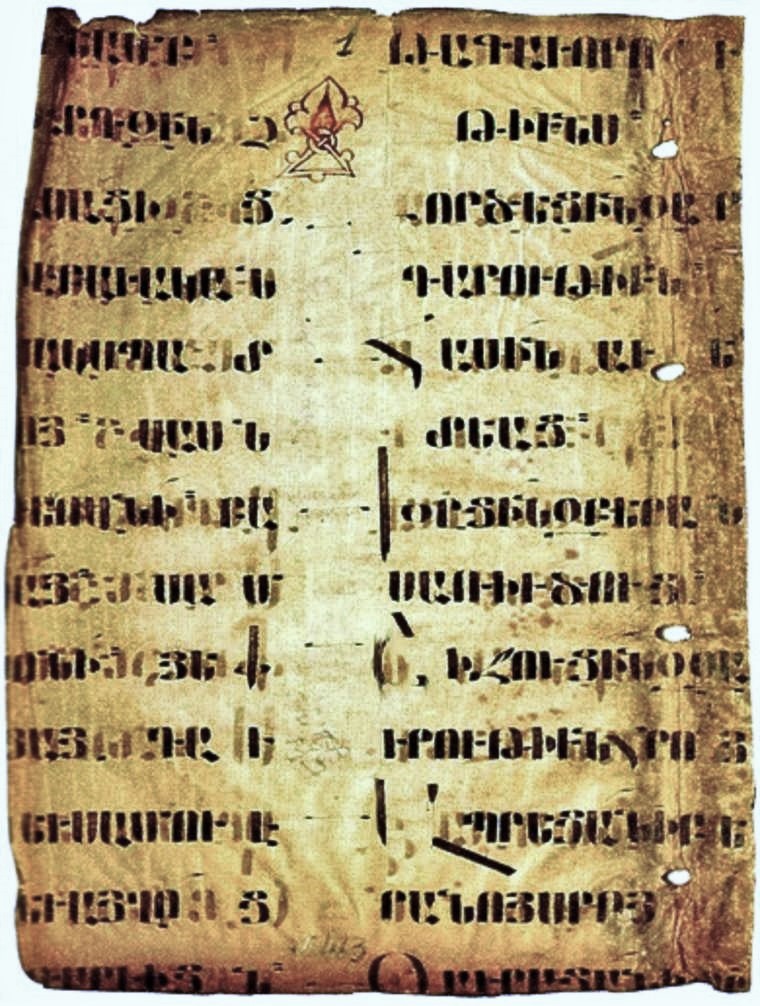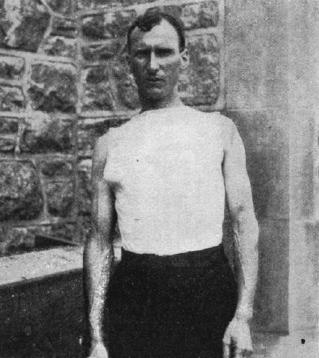|
Vahan Terian
Vahan Terian (; February 9, 1885 – January 7, 1920) was an Armenian poet, lyrist and public activist. He is known for his sorrowful, romantic poems, the most famous of which are still read and sung in their musical versions. Biography Terian was born in the Gandza village (განძანი) of Javakheti region of Georgia (then in Russian Empire). Schooled in Tiflis, he then studied at the Lazarian College in Moscow, where he was exposed to symbolism and joined the Russian Social Democrats. He was jailed by Czarist police for his political activity. He is mostly known for his poems dedicated to autumn and love. That's why Teryan is known as "Singer of Autumn" in Literature. He published his first book of poems, "Dreams at Dusk", in 1908, which made him an immediate sensation, Hovhannes Tumanian calling him the most original lyric poet of his age. He later published "Night Remembrance", "The Golden Legend", "The Return", "The Golden Link", "In the Land of Nairi" ... [...More Info...] [...Related Items...] OR: [Wikipedia] [Google] [Baidu] |
Tiflis Governorate
The Tiflis Governorate was a province ('' guberniya'') of the Caucasus Viceroyalty of the Russian Empire with its administrative center in Tiflis (present-day Tbilisi). In 1897, it constituted 44,607 sq. kilometres in area and had a population of 1,051,032 inhabitants.Brockhaus and Efron EncyclopaediaTiflis Governorate The Tiflis Governorate bordered the Elizavetpol Governorate to the southeast, the Erivan Governorate to the south, the Kars Oblast to the southwest, the Batum Oblast to the west, the Kutaisi Governorate to the northwest, the Terek Oblast to the north, the Dagestan Oblast to the northeast, and after 1905, the Zakatal Okrug to the east. The governorate covered areas of central and southeastern Georgia, the partially recognised state of South Ossetia, most of the Lori Province of Armenia, small parts of northwestern Azerbaijan, and a minuscule southern part of Ingushetia within Russia. History Tiflis Governorate was established in 1846 along with the Kut ... [...More Info...] [...Related Items...] OR: [Wikipedia] [Google] [Baidu] |
Armenian Language
Armenian ( classical: , reformed: , , ) is an Indo-European language and an independent branch of that family of languages. It is the official language of Armenia. Historically spoken in the Armenian Highlands, today Armenian is widely spoken throughout the Armenian diaspora. Armenian is written in its own writing system, the Armenian alphabet, introduced in 405 AD by the priest Mesrop Mashtots. The total number of Armenian speakers worldwide is estimated between 5 and 7 million. History Classification and origins Armenian is an independent branch of the Indo-European languages. It is of interest to linguists for its distinctive phonological changes within that family. Armenian exhibits more satemization than centumization, although it is not classified as belonging to either of these subgroups. Some linguists tentatively conclude that Armenian, Greek (and Phrygian) and Indo-Iranian were dialectally close to each other;''Handbook of Formal Languages'' (1997p. ... [...More Info...] [...Related Items...] OR: [Wikipedia] [Google] [Baidu] |
People From Samtskhe–Javakheti
A person ( : people) is a being that has certain capacities or attributes such as reason, morality, consciousness or self-consciousness, and being a part of a culturally established form of social relations such as kinship, ownership of property, or legal responsibility. The defining features of personhood and, consequently, what makes a person count as a person, differ widely among cultures and contexts. In addition to the question of personhood, of what makes a being count as a person to begin with, there are further questions about personal identity and self: both about what makes any particular person that particular person instead of another, and about what makes a person at one time the same person as they were or will be at another time despite any intervening changes. The plural form "people" is often used to refer to an entire nation or ethnic group (as in "a people"), and this was the original meaning of the word; it subsequently acquired its use as a plural form of p ... [...More Info...] [...Related Items...] OR: [Wikipedia] [Google] [Baidu] |
1920 Deaths
Nineteen or 19 may refer to: * 19 (number), the natural number following 18 and preceding 20 * one of the years 19 BC, AD 19, 1919, 2019 Films * ''19'' (film), a 2001 Japanese film * ''Nineteen'' (film), a 1987 science fiction film Music * 19 (band), a Japanese pop music duo Albums * ''19'' (Adele album), 2008 * ''19'', a 2003 album by Alsou * ''19'', a 2006 album by Evan Yo * ''19'', a 2018 album by MHD * ''19'', one half of the double album '' 63/19'' by Kool A.D. * '' Number Nineteen'', a 1971 album by American jazz pianist Mal Waldron * ''XIX'' (EP), a 2019 EP by 1the9 Songs * "19" (song), a 1985 song by British musician Paul Hardcastle. * "Nineteen", a song by Bad4Good from the 1992 album ''Refugee'' * "Nineteen", a song by Karma to Burn from the 2001 album ''Almost Heathen''. * "Nineteen" (song), a 2007 song by American singer Billy Ray Cyrus. * "Nineteen", a song by Tegan and Sara from the 2007 album '' The Con''. * "XIX" (song), a 2014 song by Slip ... [...More Info...] [...Related Items...] OR: [Wikipedia] [Google] [Baidu] |
1875 Births
Events January–March * January 1 – The Midland Railway of England abolishes the Second Class passenger category, leaving First Class and Third Class. Other British railway companies follow Midland's lead during the rest of the year (Third Class is renamed Second Class in 1956). * January 5 – The Palais Garnier, one of the most famous opera houses in the world, is inaugurated in Paris. * January 12 – Guangxu Emperor, Guangxu becomes the 11th Qing Dynasty Emperor of China at the age of 3, in succession to his cousin. * January 14 – The newly proclaimed King Alfonso XII of Spain (Queen Isabella II's son) arrives in Spain to restore the monarchy during the Third Carlist War. * February 3 – Third Carlist War – Battle of Lácar: Carlist commander Torcuato Mendiri, Torcuato Mendíri secures a brilliant victory, when he surprises and routs a Government force under General Enrique Bargés at Lácar, east of Estella, nearly capturing newly cr ... [...More Info...] [...Related Items...] OR: [Wikipedia] [Google] [Baidu] |
Armenian Activists
Armenian may refer to: * Something of, from, or related to Armenia, a country in the South Caucasus region of Eurasia * Armenians, the national people of Armenia, or people of Armenian descent ** Armenian Diaspora, Armenian communities across the world * Armenian language, the Indo-European language spoken by the Armenian people ** Armenian alphabet, the alphabetic script used to write Armenian ** Armenian (Unicode block) * Armenian Apostolic Church * Armenian Catholic Church People * Armenyan, or in Western Armenian, an Armenian surname **Haroutune Armenian (born 1942), Lebanon-born Armenian-American academic, physician, doctor of public health (1974), Professor, President of the American University of Armenia **Gohar Armenyan (born 1995), Armenian footballer ** Raffi Armenian (born 1942), Armenian-Canadian conductor, pianist, composer, and teacher Others * SS ''Armenian'', a ship torpedoed in 1915 See also * * Armenia (other) * Lists of Armenians This i ... [...More Info...] [...Related Items...] OR: [Wikipedia] [Google] [Baidu] |
Vahan Terian's Tombstone At Komitas Pantheon, Yerevan , of Armenian origin meaning "shield"
{{disambiguation, geo ...
Vahan may refer to: * Vahana, a Sanskrit word meaning "vehicle", more specifically "a vehicle of consciousness" * volkswagen derived from sanskrit root "Lokvahan" * Vahan, Armenia, a town * Vahan, Iran, a village in Hamadan Province, Iran * VAHAN (firearm), an Armenian manufactured assault rifle * Vahan (given name) Vahan ( hy, Վահան) is a given name. A common name variation of this name is Vaan (russian: Ваан). People with the given name Vahan include: *Vahan (Byzantine commander) (died 636), Eastern Roman Byzantine commander of Armenian origin * Vah ... [...More Info...] [...Related Items...] OR: [Wikipedia] [Google] [Baidu] |
Komitas Pantheon
__NOTOC__ Komitas Park and Pantheon ( hy, Կոմիտասի անվան զբոսայգի և պանթեոն) is located in Yerevan's Shengavit District, on the right side of the main Arshakunyats Avenue, in Armenia. It was formed in 1936 after the demolition of the "Mler" cemetery and its historic chapel. Many outstanding figures of Armenia's artistic world are buried here, including Komitas (1869–1935), the founder of Armenian national music, for whom it is named. Notable interments There are 60 burials at the Komitas Panthoen. Below is the list of some of the more notable burials: See also * History of Yerevan *Armenian Pantheon of Tbilisi The Armenian Pantheon of Tbilisi, also known as Khojivank ( ka, ხოჯივანქი ''Khojivank'i''; hy, Խոջիվանք) or Khojavank ( hy, Խոջավանք), is an Armenian architectural complex in north-eastern part of Avlabari ... References External linksArmenianPages.com — Komitas Park, the Pantheon of Pro ... [...More Info...] [...Related Items...] OR: [Wikipedia] [Google] [Baidu] |
Yerevan
Yerevan ( , , hy, Երևան , sometimes spelled Erevan) is the capital and largest city of Armenia and one of the world's oldest continuously inhabited cities. Situated along the Hrazdan River, Yerevan is the administrative, cultural, and industrial center of the country, as its primate city. It has been the capital since 1918, the fourteenth in the history of Armenia and the seventh located in or around the Ararat Plain. The city also serves as the seat of the Araratian Pontifical Diocese, which is the largest diocese of the Armenian Apostolic Church and one of the oldest dioceses in the world. The history of Yerevan dates back to the 8th century BCE, with the founding of the fortress of Erebuni in 782 BCE by King Argishti I of Urartu at the western extreme of the Ararat Plain. Erebuni was "designed as a great administrative and religious centre, a fully royal capital." By the late ancient Armenian Kingdom, new capital cities were established and Yerevan declined i ... [...More Info...] [...Related Items...] OR: [Wikipedia] [Google] [Baidu] |


_1938.jpg)

